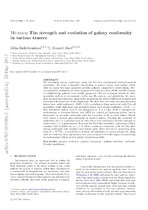| dc.contributor.author | Rafieferantsoa, Mika H. | |
| dc.contributor.author | Dave, Romeel | |
| dc.date.accessioned | 2018-02-15T08:41:28Z | |
| dc.date.available | 2018-02-15T08:41:28Z | |
| dc.date.issued | 2017 | |
| dc.identifier.citation | Rafieferantsoa, M. & Dave, R. (2017). MUFASA: The strength and evolution of galaxy conformity in various tracers | en_US |
| dc.identifier.issn | 0035-8711 | |
| dc.identifier.uri | http://dx.doi.org/10.1093/mnras/stx3293 | |
| dc.identifier.uri | http://hdl.handle.net/10566/3491 | |
| dc.description.abstract | We investigate galaxy conformity using the Mufasa cosmological hydrodynamical
simulation. We show a bimodal distribution in galaxy colour with radius, albeit
with too many low-mass quenched satellite galaxies compared to observations. Mufasa
produces conformity in observed properties such as colour, sSFR, and Hi content;
i.e neighbouring galaxies have similar properties. We see analogous trends in other
properties such as in environment, stellar age, H2 content, and metallicity. We intro-
duce quantifying conformity using S(R), measuring the relative difference in upper and
lower quartile properties of the neighbours.We show that low-mass and non-quenched
haloes have weak conformity (S(R) < 0.5) extending to large projected radii R in all
properties, while high-mass and quenched haloes have strong conformity (S(R) ~ 1)
that diminishes rapidly with R and disappears at R & 1 Mpc. S(R) is strongest for
environment in low-mass haloes, and sSFR (or colour) in high-mass haloes, and is
dominated by one-halo conformity with the exception of Hi in small haloes. Metal-
licity shows a curious anti-conformity in massive haloes. Tracking the evolution of
conformity for z = 0 galaxies back in time shows that conformity broadly emerges as
a late-time (z < 1) phenomenon. However, for fixed halo mass bins, conformity is fairly
constant with redshift out to z > 2. These trends are consistent with the idea that
strong conformity only emerges once haloes grow above Mufasa’s quenching mass
scale of ~ 1012M⊙. A quantitative measure of conformity in various properties, along
with its evolution, thus represents a new and stringent test of the impact of quenching
on environment within current galaxy formation models. | en_US |
| dc.language.iso | en | en_US |
| dc.publisher | Oxford University Press | en_US |
| dc.rights | This is the pre-print version (from arXiv:1707.01950) of the article published online at: http://dx.doi.org/10.1093/mnras/stx3293 | |
| dc.subject | Galaxies | en_US |
| dc.subject | Evolution | en_US |
| dc.subject | Formation | en_US |
| dc.subject | Statistics | en_US |
| dc.subject | N-body simulations | en_US |
| dc.title | MUFASA: The strength and evolution of galaxy conformity in various tracers | en_US |
| dc.type | Article | en_US |
| dc.privacy.showsubmitter | FALSE | |
| dc.status.ispeerreviewed | TRUE | |
| dc.description.accreditation | Scopus | |
| dc.description.accreditation | ISI | |

